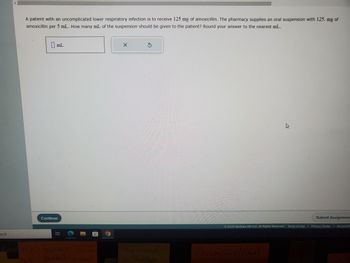
Chemistry
10th Edition
ISBN: 9781305957404
Author: Steven S. Zumdahl, Susan A. Zumdahl, Donald J. DeCoste
Publisher: Cengage Learning
expand_more
expand_more
format_list_bulleted
Concept explainers
Question

Transcribed Image Text:arch
A patient with an uncomplicated lower respiratory infection is to receive 125 mg of amoxicillin. The pharmacy supplies an oral suspension with 125. mg of
amoxicillin per 5 mL. How many mL of the suspension should be given to the patient? Round your answer to the nearest mL.
mL
Continue
8:
Fase RK- burial- Send papers
burial-go ahead
WE
X
The Grand
in Buffale
Submit Assignmen
02023 McGraw Hill LLC. All Rights Reserved. Terms of Use | Privacy Center | Accessibil
MYNSTILLSOFON
Christopher Mitchell
Expert Solution
This question has been solved!
Explore an expertly crafted, step-by-step solution for a thorough understanding of key concepts.
This is a popular solution
Trending nowThis is a popular solution!
Step by stepSolved in 3 steps

Knowledge Booster
Learn more about
Need a deep-dive on the concept behind this application? Look no further. Learn more about this topic, chemistry and related others by exploring similar questions and additional content below.Similar questions
- 1a. Medical saline typically consists of 4.50 g of NaCl in 500.0 mL of solution. What is the molarity of this solution? What is the molality of this solution? (Use the density of water = 1 g/mL; for this question, since the concentration is dilute you may assume that the added NaCl does not result in a change in volume when it is added to water.) Do your answers make sense? Would either of these values potentially depend on temperature? 1b. Stomach acid is essentially a solution of hydrochloric acid (HCl). When first secreted, stomach acid has a concentration of roughly 0.160 M HCl. How many moles of HCl are present in 50.0 mL of stomach acid? 1c. If 5.0 mL of saline is introduced to 15 mL of stomach acid. What is the mole fraction of NaCl? What is the mole fraction of HCl? (In your calculations, use the molarities from parts (a) and (b) above).arrow_forwardA chemistry student needs 75.00 g of acetyl bromide for an experiment. She has available 150. g of a 15.9% w/w solution of acetyl bromide in benzene. Calculate the mass of solution the student should use. If there's not enough solution, press the "No solution" button. Round your answer to 3 significant digits. No х10 solutionarrow_forwardDetermine the mass of NaCl needed to make the following solution: 2.7 % NaCl in a total volume of 146 mL Give your answer in units of grams, rounded to two places after the decimal placearrow_forward
- In the laboratory you are asked to make a 0.250 m iron(III) acetate solution using 15.0 grams of iron(III) acetate. How much water should you add? gramsarrow_forwardCalculate the mass of a 400.0 ml solution with a density of 1.5g/mlarrow_forwardH2S + 2 NaOH Na2S + 2 H2OCalculate the normality of a solution that contains 3.10 grams of H2S in 843 mL of solution. ____Narrow_forward
- 150 mCi of D2O is injected in your patient. 10% of D2O is excreted. The concentration of D2O in a plasma sample is found to be 0.4 mCi/100 ml. What is your patient' s Total Body Water in L?arrow_forwardIf a total of 125 mL of a 10% solution is diluted to 500 mL in a 500-mL volumetric flask, what is the concentration of the resulting new solution? You are asked to make a 1/2 dilution using 1.5 mL of serum. How much diluent do you need to use? If you make a five-tube twofold dilution using 2 mL of serum, what is the concentration of serum in tube #4?arrow_forwardA patient is given an IV drip at a rate of 110 mL per hour for a total of 6.2 hours. The IV has a calcium ion concentration of 5.94 mEq/L. How many grams of calcium ion were delivered to the patient through the IV?arrow_forward
arrow_back_ios
arrow_forward_ios
Recommended textbooks for you
 ChemistryChemistryISBN:9781305957404Author:Steven S. Zumdahl, Susan A. Zumdahl, Donald J. DeCostePublisher:Cengage Learning
ChemistryChemistryISBN:9781305957404Author:Steven S. Zumdahl, Susan A. Zumdahl, Donald J. DeCostePublisher:Cengage Learning ChemistryChemistryISBN:9781259911156Author:Raymond Chang Dr., Jason Overby ProfessorPublisher:McGraw-Hill Education
ChemistryChemistryISBN:9781259911156Author:Raymond Chang Dr., Jason Overby ProfessorPublisher:McGraw-Hill Education Principles of Instrumental AnalysisChemistryISBN:9781305577213Author:Douglas A. Skoog, F. James Holler, Stanley R. CrouchPublisher:Cengage Learning
Principles of Instrumental AnalysisChemistryISBN:9781305577213Author:Douglas A. Skoog, F. James Holler, Stanley R. CrouchPublisher:Cengage Learning Organic ChemistryChemistryISBN:9780078021558Author:Janice Gorzynski Smith Dr.Publisher:McGraw-Hill Education
Organic ChemistryChemistryISBN:9780078021558Author:Janice Gorzynski Smith Dr.Publisher:McGraw-Hill Education Chemistry: Principles and ReactionsChemistryISBN:9781305079373Author:William L. Masterton, Cecile N. HurleyPublisher:Cengage Learning
Chemistry: Principles and ReactionsChemistryISBN:9781305079373Author:William L. Masterton, Cecile N. HurleyPublisher:Cengage Learning Elementary Principles of Chemical Processes, Bind...ChemistryISBN:9781118431221Author:Richard M. Felder, Ronald W. Rousseau, Lisa G. BullardPublisher:WILEY
Elementary Principles of Chemical Processes, Bind...ChemistryISBN:9781118431221Author:Richard M. Felder, Ronald W. Rousseau, Lisa G. BullardPublisher:WILEY

Chemistry
Chemistry
ISBN:9781305957404
Author:Steven S. Zumdahl, Susan A. Zumdahl, Donald J. DeCoste
Publisher:Cengage Learning

Chemistry
Chemistry
ISBN:9781259911156
Author:Raymond Chang Dr., Jason Overby Professor
Publisher:McGraw-Hill Education

Principles of Instrumental Analysis
Chemistry
ISBN:9781305577213
Author:Douglas A. Skoog, F. James Holler, Stanley R. Crouch
Publisher:Cengage Learning

Organic Chemistry
Chemistry
ISBN:9780078021558
Author:Janice Gorzynski Smith Dr.
Publisher:McGraw-Hill Education

Chemistry: Principles and Reactions
Chemistry
ISBN:9781305079373
Author:William L. Masterton, Cecile N. Hurley
Publisher:Cengage Learning

Elementary Principles of Chemical Processes, Bind...
Chemistry
ISBN:9781118431221
Author:Richard M. Felder, Ronald W. Rousseau, Lisa G. Bullard
Publisher:WILEY